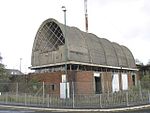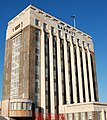
Ernő Goldfinger was a Hungarian-born British architect and designer of furniture. He moved to the United Kingdom in the 1930s, and became a key member of the Modernist architectural movement. He is most prominently remembered for designing residential tower blocks, some of which are now listed buildings.
Brutalist architecture is an architectural style that emerged during the 1950s in the United Kingdom, among the reconstruction projects of the post-war era. Brutalist buildings are characterised by minimalist constructions that showcase the bare building materials and structural elements over decorative design. The style commonly makes use of exposed, unpainted concrete or brick, angular geometric shapes and a predominantly monochrome colour palette; other materials, such as steel, timber, and glass, are also featured.

Balfron Tower is a 26-storey residential building in Poplar, Tower Hamlets, East London. Built in a Brutalist style, it forms part of the Brownfield Estate, an area of social housing between Chrisp Street Market and the A12 northern approach to the Blackwall Tunnel. It was designed by Ernő Goldfinger in 1963 for the London County Council, built 1965–67 by the GLC, and has been a listed building since 1996. Balfron Tower is stylistically similar to Goldfinger's later Trellick Tower in London.
The year 1959 in architecture involved some significant architectural events and new buildings.
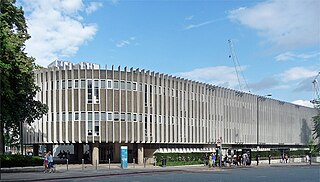
Swiss Cottage Library is a public library in the London Borough of Camden housed in an architectural landmark building on Avenue Road. Designed by Sir Basil Spence of Spence, Bonnington & Collins, it was built between 1963 and 1964.

Robin Hood Gardens is a residential estate in Poplar, London, designed in the late 1960s by architects Alison and Peter Smithson and completed in 1972. It was built as a council housing estate with homes spread across 'streets in the sky': social housing characterised by broad aerial walkways in long concrete blocks, much like the Park Hill estate in Sheffield; it was informed by, and a reaction against, Le Corbusier's Unité d'Habitation. The estate was built by the Greater London Council, but subsequently the London Borough of Tower Hamlets became the landlord.
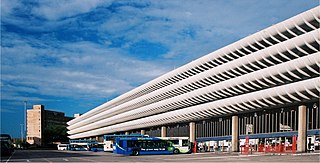
Preston bus station is the central bus station in the city of Preston in Lancashire, England. It was built by Ove Arup and Partners in the Brutalist architectural style between 1968 and 1969, to a design by Keith Ingham and Charles Wilson of Building Design Partnership with E. H. Stazicker.
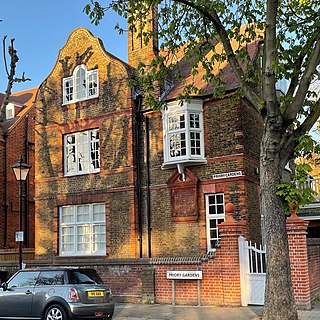
The Victorian Society is a UK charity and amenity society that campaigns to preserve and promote interest in Victorian and Edwardian architecture and heritage built between 1837 and 1914 in England and Wales. As a statutory consultee, by law it must be notified of any work to a listed building which involves any element of demolition or structural alteration.
Chamberlin, Powell and Bon was a British firm of architects. They are best known for having designed the Barbican Estate in central London.
Gavin Mark Stamp was a British writer, television presenter and architectural historian.

Building Design, or BD, is a British weekly architectural magazine, based in London.

St Paul's Bow Common is a 20th-century church in Bow Common, London, England. It is an Anglican church in the Diocese of London. The church is at the junction of Burdett Road and St Paul's Way in the London Borough of Tower Hamlets. It replaced an earlier church that was designed by Rohde Hawkins in 1858 and financed by William Cotton of Leytonstone. Consecrated by Bishop Charles James Blomfield, this church was largely destroyed in the Second World War and demolished in the 1950s.

The Excalibur Estate was a post-war 1940s housing estate of 189 prefabricated houses in Catford, South London. The estate contained the last sizeable collection of post-war prefabricated houses in the United Kingdom. In 2011, Lewisham Council approved a plan to replace the prefabs with 371 houses, with demolition scheduled to begin in 2013. English Heritage has granted listed building status to six of the "prefab" houses. The proposed demolition led to campaigns by residents, English Heritage and the Twentieth Century Society to save the properties, with an unsuccessful legal challenge to prevent redevelopment, and a return to parkland, if they were demolished. Apart from the six with Grade II listing, all the buildings are due for demolition, and the redeveloped estate completed, by the mid 2020's.

Catherine Ailsa "Kate" Macintosh MBE is a Scottish architect known for her work for local authorities. She designed Dawson's Heights in Southwark and 269 Leigham Court Road, a Grade II listed building in Lambeth.

The Co-op Mosaic is a mural in Kingston upon Hull, England, designed by the artist Alan Boyson. Commissioned by the Hull and East Riding Co-operative Society for the exterior of the end of their new store, the mural is sited at the junction of Jameson Street and King Edward Street, now a mainly pedestrianised area created for the City of Culture 2017. The building was erected by 1963. Depicting three stylised trawlers, it commemorates Hull's fishing fleet.

Elain Harwood Hon.FRIBA was a British architectural historian with Historic England and a specialist in post–Second World War English architecture.

The statue of John Betjeman at St Pancras railway station, London is a depiction in bronze by the sculptor Martin Jennings. The statue was designed and cast in 2007 and was unveiled on 12 November 2007 by Betjeman's daughter, Candida Lycett Green and the then Poet Laureate Andrew Motion to commemorate Betjeman and mark the opening of St Pancras International as the London terminus of the Eurostar high-speed rail link between Great Britain and mainland Europe. The location memorialises the connection between St Pancras station and Betjeman, an early and lifelong advocate of Victorian architecture.
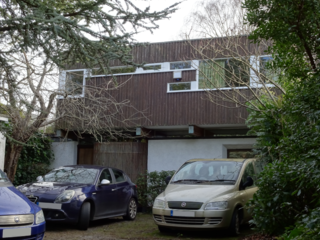
Cedarwood is a Grade II* listed house on Beaconsfield Road in Woolton, Liverpool, United Kingdom. It is most famous for being Woman's Journal's House of the Year for 1960. Designed by Beech and Prys Thomas, its "outstanding design, excellent detailing and remarkable preservation" led to it becoming a listed building by Historic England in 2007.
Robert Maguire (1931-2019) was an influential British modernist architect and leading thinker in the British liturgical architectural movement of the Church of England. Maguire’s St Paul’s Church at Bow Common was voted the best church of the twentieth century in the UK.

The Church of St Mary and St Joseph is a 20th-century Roman Catholic parish church in Tower Hamlets, London, England.









